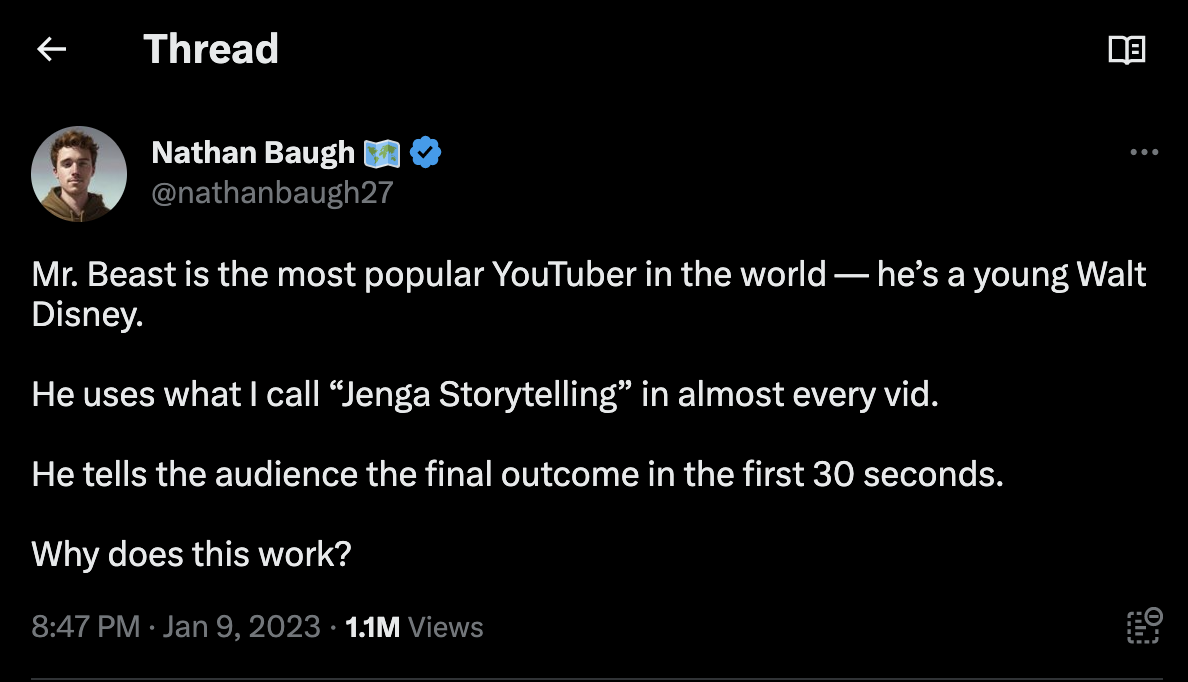Can you use in the logic of jenga in content marketing for B2B? Let’s see.
“Marketing is no longer about the stuff that you make but about the stories you tell.” – Seth Godin
If you have ever listened to a TED Talk presentation, you must have observed that the speaker always uses real-life experiences and stories to convey a message to the audience. Impactful stories can make specific topics relatable, so people love listening to them.
When it comes to content marketing, if you want your audience to resonate with your product or service, you must learn the art and science of storytelling to help you accomplish that.
Is brand storytelling a new concept?
Not really, as more and more businesses are realizing the need to appeal to customers and prospects via the age-old method of storytelling. The best stories carry emotional impact, deliver a core message, and are tucked in the memory.
According to a survey, 92% of consumers prefer stories in brand marketing. The impact is so much so that the prospects of telling stories as part of direct and indirect marketing initiatives are becoming a strategic priority.
So instead of telling you the usual – have a hero, create a villain, build a story and visualize a journey, I’m here to share the one tactic I learned from Twitter – Jenga Storytelling.
This blog and idea is all thanks to this tweet from Nathan who broke it down:

Quick recap: What is Jenga?
Jenga is derived from the Swahili word Kujenga meaning “to build.” It is a well-known game that is simple, inclusive, and fun, and it is way more than just building a tower of blocks. Jenga is all about building patience, relationships, and decision-making.
So if you read that again, you’ll realize just how close that is for what we need in content marketing.
Okay, so how does Jenga and storytelling in content marketing come together?
As marketers, the likelihood of building longer-lasting customer relationships grows exponentially when we realize there’s more to business than making a profit. And this can be made possible predominantly through storytelling.
As humans, we quickly connect emotionally to stories, notions, and characters; as consumers, we wish to feel that businesses understand us more profoundly.
In content marketing, storytelling is integral to human communication as it involves creating a narrative around a product to engage customers, evoke emotions, and inspire action.
Take, for instance, Dove Products, which put one of the classic storytelling patterns to brilliant use in their Real Beauty campaign. This content marketing campaign tells the stories of women who have overcome obstacles to develop self-confidence and appreciate themselves as beautiful. These real-life stories resonated with Dove’s audience and helped the company boost its social reach and revenue.
Let’s switch to a B2B SaaS example now – Basecamp’s Just Let Me Do My Job campaign.
Instead of directly selling their project management tool, Basecamp actually went ahead and collected stories from professionals across different departments and industries. All they needed to do was streamline what stories they wanted to hear – in this case, it was all around what actually kept people away from doing their job well.
Today, just like Dove, it is a campaign that everyone relates to. And the success lies in the number of people who went from relating to converting!

Oftentimes, marketers just throw facts, figures, features, and data at their target audience. But the bottom line is that the consumers don’t want to be overwhelmed by facts about your brand; they want an authentic, meaningful connection.
Giving away the ending right at the beginning can have your readers hooked, wondering how you got there. It’s up to you to build the narrative along the way.
What Is Jenga Storytelling in Content Marketing?
Storytelling in content marketing involves sharing a story that shows pain points and challenges that ties back to what you’re offering. In Jenga storytelling, you cut to the chase, and the reader isn’t stuck endlessly scrolling to find the outcome.
The Hero’s Journey.
Countless adventurous books and movies follow the format of a hero’s journey. Using this method to create content, you take your audience on their hero’s journey. This is one of the most effective methods to generate engagement.
For instance, in How I met your mother, we know the character Ted Mosby meets his future wife, but the intense journey he went through to meet her is what keeps the audience hooked.
You can use a similar approach in content marketing, where you have to deeply understand the challenges your buyers go through and showcase that your product could be the solution to all their problems.
Create your customer experience journey by involving your audience who face the challenge of achieving their goal by following this structure:
- The hero has a problem/challenge
- The hero decides to overcome challenges
- The hero succeeds
Outline these elements:
- Character
- The Challenge
- The opportunity
- Battle
- Success
Using Jenga storytelling, we show that the hero has won the battle and then further delve into his challenges and how they achieved success.
Benefits of Using Jenga Storytelling in Content Marketing
It’s becoming harder to capture the attention of busy consumers. But storytelling makes your brand more impressive, relatable, reliable, and unique, leading to a more engaged audience and excellent search engine rankings.
Here are five benefits for people who utilize Jenga storytelling as part of their content marketing strategies:
- It helps build a stronger connection with your audience.
- It adds a human component to your brand, making it appear more authentic and reliable.
- It binds together content that may otherwise seem disconnected
- It allows organizations to share their vision and brand values in a way that captures the reader’s attention
- It helps build brand loyalty
How to implement Jenga Storytelling in Content Marketing
Implementing Jenga storytelling in content marketing should have the same essential elements as an engaging book or a movie, a relatable character, conflict, and a solution. Portraying your product or service as the protagonist is the most essential.
Here is a list of steps to help you implement storytelling into your content marketing:
1. Give away the ending in the beginning
Most YouTubers like Mr. Beast give away the suspense within the first minute of the video, yet they amass millions of views.
Use your opening to create a gap in your story that your audience wants filled. This tactic makes the audience wonder how they get to the end. It creates a sense of mystery and a need to fill the gap in your story. Tell your viewers how their lives will be transformed with your product, then delve into the features that make it happen.
2. Find Your Character, Aka the Protagonist
Your target audience will find your story relevant and relatable only if the central character is someone they can easily relate with. If they can relate to the character, they’ll be able to empathize with it, without which it’s nearly impossible to make them understand your story.
You may have a lot of choices for the character of your story, but it’s vital to find the right one that your audience can relate to the most. Understand their likes, dislikes, objectives, pain points, and expectations so that you can package all these essential features into your story’s protagonist and create the one that your target audience will relate to.
You can also use yourself as the character and let the readers know about your own challenges that spurred the idea for your product or service. Doing so highlights your product’s benefits, humanizes your brand, and allows your readers to connect with it emotionally.
3. Add Conflict
All good stories have conflict. When the protagonist faces problems in reaching their objective, it creates tension and keeps the audience reading with the expectation of a positive conclusion.
For instance, if you’re writing about your own experiences with your business, try telling the audience if you try something else before starting your business. Did you have to overcome any obstacles, or was there some funding you had to secure for your idea to come to fruition? Talk about all this and tell your audience how you resolve your conflicts and overcome your challenges.
4. Highlight the stakes right off the bat
What are the stakes for your consumers? What are they losing if they don’t use your products or services?
Highlighting the stakes helps in adding emotions for your readers to connect with. It doesn’t have to be too dramatic, but it’s helpful for them to see how your products or services can benefit them.
5. Keep it simple and authentic
Don’t we all love authenticity, even in the simplest things in life?
We all love authentic brands, and it’s a fact that authenticity is the fastest way to connect with another human being. You wouldn’t want your story to sound salesy; instead, you should focus on communicating with consumers to make the product purchase happen naturally.
So, keep your stories authentic and simple and see how your audience develops trust in your brand. Ensure that you only talk about relevant details and don’t exaggerate the conflicts, stakes, or for that matter, even the effects of your products and services. Don’t make it sound like a fairy tale where readers have to wait for plot twists and turns.
Stay true to your brand and share a genuine and unique story. Engaging content that pushes people to take action is always unique and genuine. And if your brand is innovative and creative, your target consumers are sure to notice and respond positively.
6. Connect emotionally with your audience
Storytelling in itself is possibly the best way to hit that emotional chord with your consumers. But, if your story doesn’t truly connect with your audience, all your efforts are futile.
If you cannot truly connect with your audience, all your efforts are futile. Usually, people don’t want to buy products from a pushy salesperson. Instead, they want someone who shows an interest in what they’re selling and uses verifiable facts to do so.
People are willing to hear you out when you can build a good rapport with them. You’re already halfway there through the use of a story which shows that you are putting the effort to get their attention. The best stories should include components people resonate with and encourage customers to continue building relationships with your brand.
7. Use data to create a touching story
You should include some data when creating a story to help market your products or services. After all, generating higher returns and increased engagement is equally essential for successful content marketing. Using visual props to demonstrate data from studies throughout your content marketing will only help your readers visualize the facts. When the story and visuals are both compelling and factual, there’s a higher chance that your audience will relate and connect.
For instance, studies show that hugs help stabilize babies’ vital signs and stimulate brain development. Huggies, the baby product company, used similar data and created ads that showed parents hugging their babies, calling the campaign “No Baby Unhugged.” This campaign used actual, tangible data to tell a vital story and subtly encourage consumers to choose them over their competitors.
Wrapping it Up
Incorporating storytelling techniques can be a powerful tool for content marketers seeking to reach and stand out in the minds of their audiences. Storytelling is one of the fastest ways to build trust, stand apart from the crowd, and create deeper connections with your consumers. Embracing personal narratives and genuinely telling compelling stories can evoke emotions in your customers and resonate with them.
Want to talk about using storytelling in B2B content marketing?




